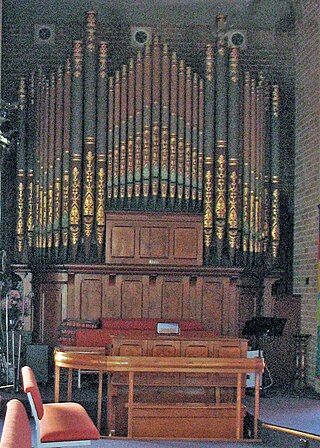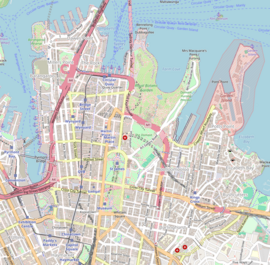
Congregational churches are Protestant churches in the Reformed (Calvinist) tradition practicing congregationalist church governance, in which each congregation independently and autonomously runs its own affairs.

John Fairfax was an English-born journalist, company director, politician, librarian and newspaper owner, known for the incorporation of the major newspapers of modern-day Australia.

Brougham Place Uniting Church is a Uniting church located at Brougham Place, North Adelaide, South Australia. It was formerly called the North Adelaide Congregational Church and affiliated with the Congregational Church.

Christ Church St Laurence is an Anglican church located at 814 George Street, near Central railway station and Haymarket, in Sydney, New South Wales, Australia. It is the principal centre of Anglo-Catholic worship in the city and Diocese of Sydney, where the Anglicanism is predominantly Evangelical in character. Anglo-Catholicism is manifested at Christ Church St Laurence by an emphasis on the sacraments, ritual, music and social action, all of which have been prominent features of Anglo-Catholicism since the 19th century.
Australian non-residential architectural styles are a set of Australian architectural styles that apply to buildings used for purposes other than residence and have been around only since the first colonial government buildings of early European settlement of Australia in 1788.

Thomas Quinton Stow, generally referred to as the Rev. T. Q. Stow, but also as Quinton Stow, was an Australian pioneer Congregational minister.

St Andrew's Uniting Church is a heritage-listed Uniting church at 131 Creek Street, Brisbane CBD, City of Brisbane, Queensland, Australia. It was designed by George David Payne and built in 1905 by Alexander Lind & Son. Initially St Andrew's Presbyterian Church, it became part of the Uniting Church following the merger of the Presbyterian, Methodist and Congregational Churches in 1977. It was added to the Queensland Heritage Register on 21 October 1992.

Harry Chambers Kent (1852–1938) was an English-born Australian architect. He was Sydney-based during the late 19th and early 20th centuries and a leader of his profession as President of the Institute of Architects of NSW (1906–07). During his career he was associated with the design of over 670 buildings. Many of his designs are heritage listed and two are on the New South Wales State Heritage Register.
George Allen Mansfield was a prominent Australian architect of the nineteenth century who designed many iconic buildings in Sydney, New South Wales, Australia.

Trinity Church is a Uniting church located at 72 St Georges Terrace in Perth, Western Australia. Commenced in 1893, the former Congregational church is one of the oldest church buildings in the City of Perth, and one of the few remaining 19th-century colonial buildings in the city.

Pilgrim Uniting Church is a Uniting church located on Flinders Street, Adelaide in South Australia.

Clayton Wesley Uniting Church, formerly Clayton Congregational Church, is a Uniting church, located at 280 Portrush Road, Beulah Park, Adelaide, South Australia, Australia. The current building with its tall spire was built was built in 1883, although an earlier building, behind the present church and now known as the Lecture Hall, was built in 1856. The church is located in a commanding position at the eastern end of The Parade, Norwood.

The Galston Uniting Church Pipe Organ or Pipe Organ from Bourke Street Congregational Church is a heritage-listed church pipe organ located at 11 School Road, Galston in the Hornsby Shire local government area of New South Wales, Australia. It was built by Forster and Andrews. It is also known as Pipe Organ from Bourke Street Congregational Church (former) and Forster and Andrews Pipe Organ; Galston Uniting Church Pipe Organ. The property is owned by Uniting Church in Australia. It was added to the New South Wales State Heritage Register on 2 April 1999.

St John's Uniting Church and Pipe Organ is a heritage-listed Uniting church at Yeo Street, Neutral Bay, North Sydney Council, New South Wales, Australia. The church was built by Tafield and Collins; and the pipe organ was built by Charles Richardson. It is also known as St. John's Uniting Church and Pipe Organ and Richardson Pipe Organ. The property is owned by the Uniting Church of Australia. It was added to the New South Wales State Heritage Register on 2 April 1999.

The Randwick Presbyterian Church is a heritage-listed Presbyterian church building located at 162 Alison Road in the Sydney suburb of Randwick in the City of Randwick local government area of New South Wales, Australia. The church was designed by Sir John Sulman and built from 1889 to 1890 by George Gale. The property is owned by the Randwick Presbyterian Church and was added to the New South Wales State Heritage Register on 8 May 2008.

The Trinity Uniting Church is a heritage-listed Uniting church located at 62 The Boulevarde, in the Sydney suburb of Strathfield in the Municipality of Burwood local government area of New South Wales, Australia. It was designed by George Sydney Jones & Harry Thompson and built from 1889 to 1890 by Thomas Hanley of Balmain. It is also known as Trinity Congregational Church. The property is owned by the Uniting Church in Australia. It was added to the New South Wales State Heritage Register on 19 September 2003.

The Mariners' Church is a heritage-listed former church and seamen's mission and now nightclub, bar and restaurant located at 98–100 George Street in the inner city Sydney suburb of The Rocks in the City of Sydney local government area of New South Wales, Australia. It was designed in various stages by J. Bibb, H. C. Kent and Kent & Massie and was built from 1856 to 1859. It is also known as Mission to Seamen; Rawson Institute for Seamen & Mariners' Church; Craft Centre. The property is owned by Sydney Harbour Foreshore Authority, an agency of the Government of New South Wales. It was added to the New South Wales State Heritage Register on 10 May 2002. The building was previously a cafe, place of worship and craft centre.

St Stephen's Uniting Church is a heritage-listed Uniting Church located at 197 Macquarie Street, in the Sydney central business district, in the City of Sydney local government area of New South Wales, Australia. Developed initially as St Stephen's Presbyterian Church, it was designed by Finlay Munro Jnr and John Reid and built from 1935 to 1937 by Kell & Rigby. It was added to the New South Wales State Heritage Register on 3 September 2004.

Wales House is a heritage-listed former newspaper office building, bank building and now hotel located at 64–66 Pitt Street, in the Sydney central business district, in the City of Sydney local government area of New South Wales, Australia. It was designed by Manson & Pickering and built from 1922 to 1929 by Stuart Bros. It is also known as the Bank of NSW Building. The property is owned by Wales House Nominees Pty Ltd. It was added to the New South Wales State Heritage Register on 2 April 1999. Located on the junction of Pitt, Hunter and O'Connell Streets, the building served as offices for John Fairfax and Sons' The Sydney Morning Herald from 1927 to 1955 before being acquired by the Bank of New South Wales, commonly known as "The Wales", hence the building's name. The building has subsequently been converted into an international hotel, as part of the Radisson Blu hotel chain.

St Sophia Greek Orthodox Church, officially the St Sophia and Her Three Daughters Greek Orthodox Church, is a heritage-listed Greek Orthodox church at 411a Bourke Street in the inner city Sydney suburb of Surry Hills in the City of Sydney local government area of New South Wales, Australia. Formerly a Congregational church, the building is also known as the former Bourke Street Congregational Church and School. It was added to the New South Wales State Heritage Register on 2 April 1999.





















